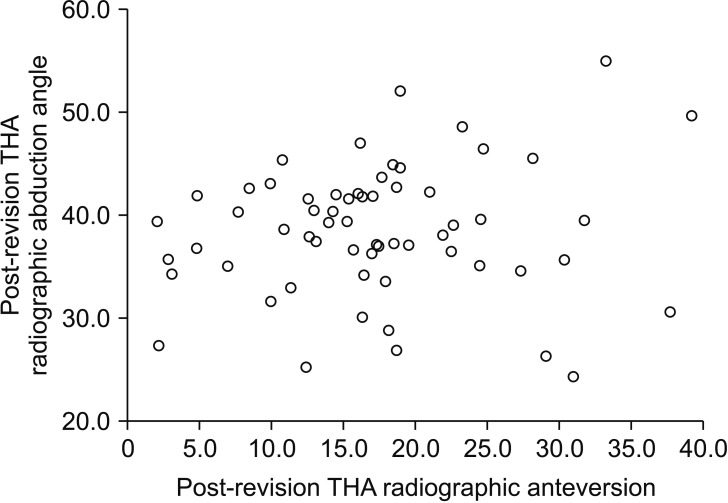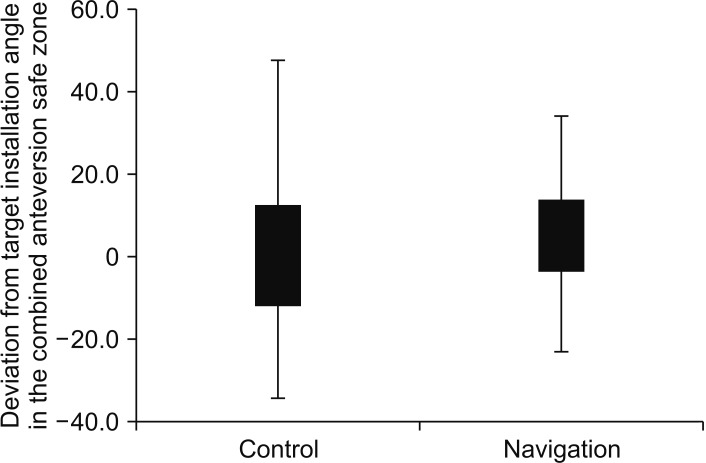Clin Orthop Surg.
2019 Mar;11(1):43-51. 10.4055/cios.2019.11.1.43.
Efficacy of Computed Tomography-Based Navigation for Cup Placement in Revision Total Hip Arthroplasty
- Affiliations
-
- 1Department of Orthopaedic Surgery, Faculty of Medicine, Oita University, Oita, Japan. nobuhiro@oita-u.ac.jp
- KMID: 2438333
- DOI: http://doi.org/10.4055/cios.2019.11.1.43
Abstract
- BACKGROUND
Navigation systems are an effective tool to improve the installation accuracy of the cup in primary total hip arthroplasty. This study aimed to evaluate the efficacy of a computed tomography-based navigation system in achieving optimal installation accuracy of implants in revision total hip arthroplasty and to clarify the usefulness of the navigation system.
METHODS
We conducted a retrospective study of 23 hips in 23 patients who underwent revision total hip arthroplasty using a computed tomography-based navigation system; the control group comprised 33 hips in 33 patients who underwent revision total hip arthroplasty without a navigation system.
RESULTS
The average cup position with the navigation system was 40.0°± 3.7° in radiographic abduction angle, 18.8°± 4.8° in radiographic anteversion, and 41.2°± 8.9° in combined anteversion; without the navigation system, the average cup position was 38.7°± 6.1°, 19.0°± 9.1°, and 33.6°± 20.5°, respectively. The achievement rate of cup positioning within the Lewinnek safe zone was not significantly different between the navigation group (82.6%) and control group (63.6%). In contrast, the achievement rate of cup positioning within the Widmer combined anteversion guidelines was significantly greater in the navigation group (78.3%) than in the control group (48.0%, p = 0.029). Furthermore, outlier cases in the navigation group had a smaller variance of deviation from the optimal cup position than those in the control group did.
CONCLUSIONS
The results show that the use of navigation for revision total hip arthroplasty improved cup positioning and reduced the range of outliers. Improvement of cup placement accuracy influenced the installation of the stem and also improved the achievement rate of combined anteversion. Thus, a computed tomography-based navigation system is very useful for surgeons when placing the cup within the target angle in revision total hip arthroplasty.
Keyword
Figure
Reference
-
1. Bozic KJ, Kurtz SM, Lau E, Ong K, Vail TP, Berry DJ. The epidemiology of revision total hip arthroplasty in the United States. J Bone Joint Surg Am. 2009; 91(1):128–133. PMID: 19122087.
Article2. Del Schutte H Jr, Lipman AJ, Bannar SM, Livermore JT, Ilstrup D, Morrey BF. Effects of acetabular abduction on cup wear rates in total hip arthroplasty. J Arthroplasty. 1998; 13(6):621–626. PMID: 9741436.
Article3. Lachiewicz PF, Soileau E, Ellis J. Modular revision for recurrent dislocation of primary or revision total hip arthroplasty. J Arthroplasty. 2004; 19(4):424–429. PMID: 15188099.
Article4. Digioia AM 3rd, Jaramaz B, Plakseychuk AY, et al. Comparison of a mechanical acetabular alignment guide with computer placement of the socket. J Arthroplasty. 2002; 17(3):359–364. PMID: 11938515.
Article5. Gross TP, Liu F, Webb L. Intraoperative radiographs for placing acetabular components in hip resurfacing arthroplasty. Clin Orthop Relat Res. 2011; 469(6):1554–1559. PMID: 21108028.
Article6. Kitada M, Nakamura N, Iwana D, Kakimoto A, Nishii T, Sugano N. Evaluation of the accuracy of computed tomography-based navigation for femoral stem orientation and leg length discrepancy. J Arthroplasty. 2011; 26(5):674–679. PMID: 20870379.
Article7. Kalteis T, Handel M, Bathis H, Perlick L, Tingart M, Grifka J. Imageless navigation for insertion of the acetabular component in total hip arthroplasty: is it as accurate as CT-based navigation? J Bone Joint Surg Br. 2006; 88(2):163–167. PMID: 16434517.8. Yamada K, Endo H, Tetsunaga T, Miyake T, Sanki T, Ozaki T. Accuracy of cup positioning with the computed tomography-based two-dimensional to three-dimensional matched navigation system: a prospective, randomized controlled study. J Arthroplasty. 2018; 33(1):136–143. PMID: 28870743.
Article9. Widmer KH, Zurfluh B. Compliant positioning of total hip components for optimal range of motion. J Orthop Res. 2004; 22(4):815–821. PMID: 15183439.
Article10. Lewinnek GE, Lewis JL, Tarr R, Compere CL, Zimmerman JR. Dislocations after total hip-replacement arthroplasties. J Bone Joint Surg Am. 1978; 60(2):217–220. PMID: 641088.
Article11. Callanan MC, Jarrett B, Bragdon CR, et al. The John Charnley Award: risk factors for cup malpositioning: quality improvement through a joint registry at a tertiary hospital. Clin Orthop Relat Res. 2011; 469(2):319–329. PMID: 20717858.
Article12. Yoshimine F. The safe-zones for combined cup and neck anteversions that fulfill the essential range of motion and their optimum combination in total hip replacements. J Biomech. 2006; 39(7):1315–1323. PMID: 15894324.
Article13. Sadhu A, Nam D, Coobs BR, Barrack TN, Nunley RM, Barrack RL. Acetabular component position and the risk of dislocation following primary and revision total hip arthroplasty: a matched cohort analysis. J Arthroplasty. 2017; 32(3):987–991. PMID: 27633947.
Article14. Dorr LD, Malik A, Dastane M, Wan Z. Combined anteversion technique for total hip arthroplasty. Clin Orthop Relat Res. 2009; 467(1):119–127. PMID: 18979146.
Article15. Minoda Y, Kadowaki T, Kim M. Acetabular component orientation in 834 total hip arthroplasties using a manual technique. Clin Orthop Relat Res. 2006; 445:186–191. PMID: 16467620.
Article16. Bosker BH, Verheyen CC, Horstmann WG, Tulp NJ. Poor accuracy of freehand cup positioning during total hip arthroplasty. Arch Orthop Trauma Surg. 2007; 127(5):375–379. PMID: 17297597.
Article17. Sugano N, Takao M, Sakai T, Nishii T, Miki H. Does CT-based navigation improve the long-term survival in ceramic-on-ceramic THA? Clin Orthop Relat Res. 2012; 470(11):3054–3059. PMID: 22569720.
Article18. Nakamura N, Nishii T, Kitada M, Iwana D, Sugano N. Application of computed tomography-based navigation for revision total hip arthroplasty. J Arthroplasty. 2013; 28(10):1806–1810. PMID: 23523215.
Article19. Kuroda K, Kabata T, Maeda T, et al. The value of computed tomography based navigation in revision total hip arthroplasty. Int Orthop. 2014; 38(4):711–716. PMID: 24240519.
Article20. Chang JD, Kim IS, Prabhakar S, Mansukhani SA, Lee SS, Yoo JH. Revision total hip arthroplasty using imageless navigation with the concept of combined anteversion. J Arthroplasty. 2017; 32(5):1576–1580. PMID: 28139342.
Article
- Full Text Links
- Actions
-
Cited
- CITED
-
- Close
- Share
- Similar articles
-
- Comparison of Cup Setting Angle Accuracy between Computed Tomography-Based and Computed Tomography-Free Navigation in the Same Patients with Crowe’s Classification I or II Hip Dysplasia
- Navigated Acetabular Cup Fixation for Acetabular Deformity or Revision Total Hip Arthroplasty
- The Evolution of Computer-Assisted Total Hip Arthroplasty and Relevant Applications
- Accurate Leg Length Measurement in Total Hip Arthroplasty: A Comparison of Computer Navigation and a Simple Manual Measurement Device
- Acetabular Cup Revision




